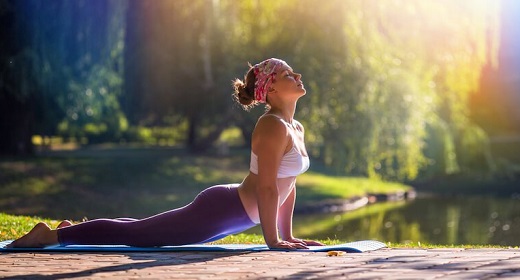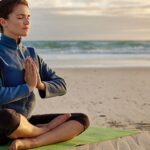Lets be honest – we all get a little stressed sometimes…
Whether it’s related to an issue at work, a fight with a friend or loved one, or problems with family, stress can creep up on us at the most unsuspecting times. Thankfully, there are coping mechanisms like doing yoga poses for anxiety, stress and depression, which help during these trying times.
In fact, practicing yoga has been shown to have a calming effect on the body, with many poses providing stress-relieving effects. According to Harvard Medical School, “by reducing perceived stress and anxiety, yoga appears to modulate stress response systems. This, in turn, decreases physiological arousal – for example, reducing the heart rate, lowering blood pressure, and easing respiration.”
A small study done at the University of Utah looked at the relationship between yoga and stress by determining the participants’ responses to pain. The researchers noted that those who had poorly regulated responses to stress were also more sensitive to pain. Their subjects were 12 experienced yoga practitioners, 14 people with fibromyalgia (a stress-related illness characterized by hypersensitivity to pain), and 16 healthy volunteers.
When the three groups were subjected to more or less painful thumbnail pressure, the participants with fibromyalgia perceived pain at lower pressure levels compared with other subjects. MRIs showed that they also had the greatest activity in areas of the brain associated with the pain response. On the flip side, the yoga practitioners had the highest pain tolerance and lowest pain-related brain activity during the MRI. The study essentially showed that yoga may be able to help a person regulate their stress, and therefore pain responses.
12 Easy Yoga Poses for Anxiety, Stress and Depression
These stress-relieving yoga poses help alleviate backaches, fatigue, anxiety and depression. Make sure that with each pose you are focusing on taking deep breaths. If any pose looks too difficult, simply skip it or don’t go as deep into the pose as the instructions provide. The more you practice a position, the easier it comes with time.
1. Child’s Pose
How It Calms: placing your head down on the mat has an instant calming and soothing effect on the brain. It sends a signal to the brain that you’re safe and that it’s okay to rest.
1. Kneel on the floor or yoga mat with legs together, sitting back on your heels.
2. Hinge forward from your hips until your chest comes to rest on your thighs. Your forehead is on the floor.
3. Curl your shoulders forward and let your hands rest, palms up, next to the feet. You can also have your arms out in front of you, palms on the floor.
4. Hold for 5 deep breaths.
2. Bridge Pose
How It Calms: since this pose acts as a mild inversion, with the heart higher than the head, it can calm your brain and central nervous system, promoting ease and relaxation in the body and mind.
1. Lying on your back, bend your knees and place your feet flat on the floor, hip-width apart. Slide your arms alongside your body with palms facing down (fingertips should lightly touch the heels).
2. Press your feet into the floor, inhale, and lift your hips, rolling your spine off the floor (keep your knees hip-width apart).
3. Press into your arms and shoulders to lift the chest and squeeze your glutes to lift the hips higher.
4. Hold for 4-8 deep breaths, then release on an exhale, slowly rolling your spine back to the floor.
3. Legs-Up-The-Wall Pose
How It Calms: a deeply relaxing pose, which when combined with slow, rhythmic breathing, will allow you to tap into your “rest and digest” nervous response. Doing this pose consistently may allow you to notice that your body feels healthier overall, and that you are better able to find a calm state of mind.
1. Sit on the floor with your hips against the wall and roll onto your back, bringing your legs up the wall.
2. Your buttocks should be pressed as close to the wall as possible.
3. Sit here for about 5 minutes, focusing on deep belly breaths.
4. Standing Forward Bend
How It Calms: calms the brain and invigorates the nervous system. It balances the energy flow throughout the body and can help you get a better sleep if you suffer from insomnia or feel particularly high strung.
1. From a standing position, feet hip-width apart, exhale forward and bend the knees enough to bring your palms flat to the floor with your head pressed against your legs. If this is too deep, just bend as far as you can go.
2. Feel your spine stretching in opposite directions, while pressing your hips up. Straighten the legs fully to deepen the stretch (if you can, that is. This is difficult even for extremely flexible people like myself!).
3. Hold for 4-8 deep breaths, bend the knees and then slowly roll your torso back up, vertebrae by vertebrae.
5. Head-to-Knee Forward Bend
How It Calms: similar to the standing forward bend, the head-to-knee forward bend calms the brain and helps reduce compression in the vertebrae from sitting for so long. This pose helps relieve mild depression, anxiety, fatigue, headaches, menstrual discomfort and insomnia.
1. Begin in a seated position with legs extended.
2. Bend your left leg, bringing the sole of the foot to the upper inside of the right thigh; left knee should rest on the floor.
3. Place both of your hands to either side of the right leg, and then inhale, turning toward the extended leg.
4. Exhale, and fold forward, so that your forehead touches the knee of the extended leg (if this is too much, just bend as far as you can toward the extended leg).
5. Hold for 5 deep breaths, and then repeat on the other side.
6. Cat and Cow
How It Calms: this breath-synchronized movement increases coordination, and invigorates the vital life force in the body. It is also associated with increased emotional balance and stability of the mind. The constant upward and downward movement of the spine improves circulation to the discs between the vertebrae, which relieves stress from the back and calms the mind.
1. Start with your hands and knees on the floor, palms directly under the shoulder rand knees directly below the hips.
2. Breathe in and pull your abdominal muscles in as you arch your back up like a stretching cat. Let your head and tailbone drop down toward the floor.
3. Return to the initial position, and then extend the upper part of the spine upwards, supporting it with your abdominal muscles and not letting your neck sink into your shoulders, or your shoulders crunch up into your neck. Make sure your neck is a long extension of your spine, and don’t let the head fall back.
4. Return to starting position and repeat 5 times.
7. Easy Pose
How It Calms: sitting upright with your spine aligned, as in this pose, helps reduce stress and anxiety. It helps calm the mind and is known to be therapeutic for stress.
1. Extend your legs in front of the body and sit straight. Cross your legs at your shins.
2. Place each foot beneath the opposite knee and hold your legs in toward the torso – if this is difficult, sit in whatever cross-legged position you can.
3. Place your hands on your knees, palms facing down.
4. Balance your weight evenly across your sit bones, aligning the head, neck and spine, and then gaze ahead with soft eyes.
5. Hold for up to one minute, then release and cross your legs the opposite direction, holding for another minute.
8. Dolphin Pose
How It Calms: this pose helps calm the brain and can help relieve stress, anxiety and mild depression. It stretches the shoulders, neck and spine, which is where we tend to hold a lot of tension.
1. Starting on all fours, lower your forearms to the ground, tucking your toes under and lifting your hips toward the ceiling.
2. Place your hands shoulder-width apart, fingers spread wide.
3. Press your forearms, fingers and palms into the floor and press your hips up and back while keeping a straight spine.
4. Keep your feet hip’s width apart with toes facing forward; press heels into the floor.
5. Let your head and neck hang freely.
6. Remain here for 2-6 deep breaths, then return to all fours.
9. Corpse Pose
How It Calms: helps relax a nervous system on over-drive, thereby quelling anxiety, stress and insomnia. It also allows your nervous system a time to reset, and drenches your body in endorphins that help relax and calm.
1. Lie flat on your back with your legs together (but not touching), and arms at your sides with palms up.
2. Keep your eyes closed and face relaxed. Focus on deep belly breaths.
3. While breathing deeply for 3-5 minutes, bring your attention to each part of the body, starting at the top of the head all the way to your toes.
10. Fish Pose
How It Calms: helps open up the front of the chest and heart space, which we often keep protected (hence why so many people have hunched shoulders – perhaps a connection to protecting the heart and our love?). Turn your attention to your heart when you hold this pose, and allow it to fill you and rejuvenate you. The more you learn to love, the less stressed you’ll be – I promise!
1. Sit on the floor with your legs extended out in front of you.
2. Move to one side at a time so that you can place your hands directly underneath each buttocks (palms facing down, fingers towards the toes).
3. Draw your elbows into each other and open your chest.
4. Slowly lean back onto your forearms and elbows.
5. Again, open your chest as much as possible and press into your arms to stay lifted.
6. Drop your head back if you haven’t had any neck injuries, and only if it is comfortable.
7. Release by lifting your head, releasing your hands and lying down on your back.
11. Locust Pose
How It Calms: a full-body energizer that narrows your focus for a few breaths, and then leaves you calm and alert when you come out of the pose. Helps calm the brain and gives peace of mind.
1. Lay down on your stomach on the floor with your arms by your sides and your forehead on the floor.
2. Keeping your pelvis and lower belly on the floor, inhale as you lift your chest, head and legs a few inches off the floor and lift your arms toward parallel with the floor.
3. Keep your knees straight, and reach your legs back as you imagine your head reaching forward.
4. Stay in this position for 5 seconds, then exhale and release your legs, chest, head and arms. Turn your head to one side and rest for a couple breaths.
5. Repeat 7-10 times.
12. Upward Facing Dog Pose
How It Calms: this pose brings awareness to your breathing, which can be a struggle for many when in an anxiety attack. It can be a good tool to utilize breath when in times of stress or anxiety. It is also great for opening up a tight chest, which will naturally allow us to feel less tense, and therefore, less agitated and stressed.
1. Start by lying on your belly with your legs extended straight back behind you and the tops of your feet relaxed down on the ground (or mat), hip-distance apart.
2. Keep your palms beside your ribs so that your elbows are bent at 90 degrees, forearms about perpendicular to the floor.
3. On an inhale, press firmly into your palms and straighten your arms, lifting your torso, hips, and tops of your thighs up off the ground. The shoulders should be stacked directly over the wrists.
4. Relax your shoulders away from your ears by rolling the shoulders back. Keep your chin in line with the floor, and avoid the urge to crank the head back to gaze at the ceiling (this will compress the neck).
5. Remain here for 5-10 deep breaths, and then lower back down on your belly.
And there you have it! The next time you’re feeling a little stressed, anxious or depressed, give these moves a try and see how you feel after. Remember – staying consistent is key.























































